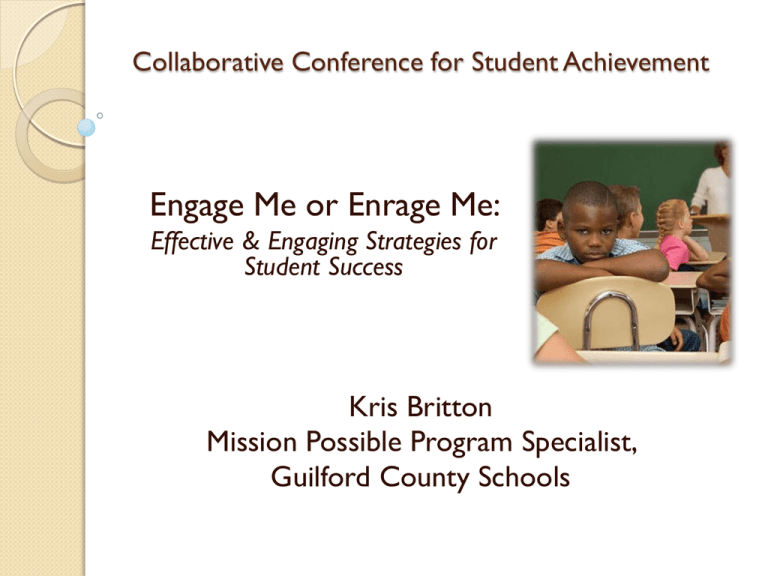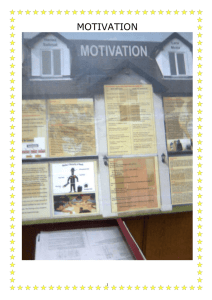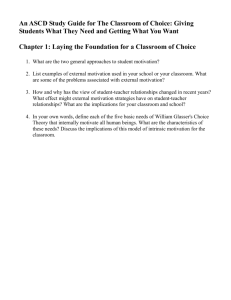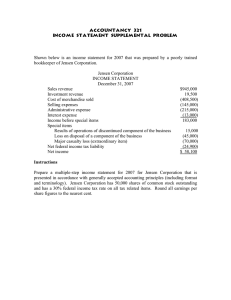Engage Me or Enrage Me: Kris Britton Mission Possible Program Specialist,
advertisement

Collaborative Conference for Student Achievement Engage Me or Enrage Me: Effective & Engaging Strategies for Student Success Kris Britton Mission Possible Program Specialist, Guilford County Schools Essential Question How do effective and engaging strategies motivate students to learn? Outcomes By the end of the session participants will … 1. 2. 3. 4. 5. Understand the research supporting student engagement Discuss reasons why students lack engagement in the classroom Identify characteristics of teachers who motivate students to learn Identify and model strategies that foster student engagement Analyze mistakes that derail student engagement NCPTS: Standard II Teachers establish a respectful environment for a diverse population of students A. B. C. D. E. Teachers provide an environment in which each child has a positive, nurturing relationship with caring adults. Teachers embrace diversity in the school community and in the world. Teachers treat students as individuals. Teachers adapt their teaching for the benefit of students with special needs. Teachers work collaboratively with the families and significant adults in the lives of their students. Agenda I. II. III. IV. V. VI. Introduction & Research Why are Students Enraged Motivation & Engagement Strategies That Foster Engagement Mistakes that Derail Engagement Questions & Feedback Research Based Practice Three Types of Students (Perensky, 2005) Self-motivated Auto Pilot Tune us out Research Based Practice Why are many students so enraged? (Perensky 2005) High Engagement at Home Lack of Choices Short Attention Spans for “Old Teaching” ―There are three important things to remember about education. The first one is motivation, the second is motivation, and the third is motivation.‖ —Terrell Bell, former U.S. Secretary of Education Research Based Practice For students to learn, they must be motivated. Alderman, M. K. (1999). Motivation for achievement: Possibilities for teaching and learning. Mahwah, NJ: Lawrence Erlbaum. Anderman, L. H., & Midgley, C. (1998). Motivation and middle school students. ERIC Digest. Champaign, IL: ERIC Clearinghouse on Elementary and Early Childhood Education. Blake Harrison, Founder, Creative Director www.flocabulary.com Brewster, C., & Fager, J. (2000, October). Increasing student engagement and motivation: From time-on-task to homework. Portland, OR: Northwest Regional Educational Laboratory. Stipek, D. J. (1996). Motivation and instruction. In D. C. Berliner & R. C. Calfee (Eds.), Handbook of educational psychology (pp. 85–113). New York: MacMillan. Motivation Six Variables of Motivation (Kagan, 2003) Success Concern Interest Meaning Knowledge of results Positive feeling tone Create Sign Language Instructions: Your group has 4 minutes to create sign language that matches each variable of motivation. You should have 6 distinct signs (movements)by the time you are done. Pause for a Cause Motivation Eight Characteristics that Motivate & Engage (Sass, 1989) Instructor's enthusiasm Relevance of the material Organization of the course Appropriate difficulty level of the material Active involvement of students Variety Rapport between teacher and students Use of appropriate, concrete, and understandable examples Design a Tee & Ball Cap Instructions TIME LIMIT: 6 MINUTES Work independently to decorate each: Tee Shirt: Pick one of the 8 characteristics of teachers who motivate and design a tee shirt for that teacher. Ball Cap: Pick a different characteristic of teachers who motivate and design a ball cap that he would not wear. Pause for a Cause Let’s Move TASK: 2 Walls & 4 Chairs INFORMATION: 3 Variables of Motivation 2 Characteristics the Motivate 1Reason students are enraged MODE: Hop, Strut, or Dance Motivation Teaching with the Brain in Mind (2003) “There is no such thing as unmotivated students. There are, however, students in unmotivated states.” Eric Jensen Motivation Teaching with the Brain in Mind (2003) Brain Communication Brain Chemical Moods & Feelings How we feel is what it real – it’s the link to what we think! Strategies for Changing States of Mind Capture the Senses Music Sound Effects Lighting Aroma / Scents Tonality Strategies for Changing States of Mind Physical Movement Change seats Crossovers Change in posture Strategies for Changing States of Mind Proximity Teacher Movement Desk Formation Student Spacing Strategies for Changing States of Mind Redirect Attention Hold Object Jokes Ask Compelling Question Tell a Story Student Engagement Three Rules of Engagement Teachers must think about learning before they think about teaching. (Jensen) The brain is not designed to get complex learning correct the first time. (Jensen) Students expect to be engaged in their daily lives, outside of the classroom. (Perensky, 2005) Three Rules of Student Engagement #1 Think about learning before teaching. (Jensen, 2003) The one doing the talking is the on doing the learning. Purposeful, constant, targeted instruction matters most. Most students are not wired to simply pay attention to a classroom lesson. Three Rules of Student Engagement #2 The brain is not designed to get complex learning correct the first time. (Jensen) We make rough drafts Feedback is necessary We need to make sense of it Three Rules of Student Engagement #3 Students expect to be engaged in their daily lives, outside of the classroom. (Perensky) Students go home to download songs, make music, make movies, play video games. Many third graders report having multiple email addresses. Students without computers report having cell phones, Ipods, and video games. Students multi-task with great proficiency, when they are interested in the tasks at hand. Research Based Practice Teaching with the Brain in Mind (2003) “Savvy teachers engage strategies based on solid research and they do them so consistently that sometimes miracles happen.” Eric Jensen Pause for a Cause Strategies that Foster Student Engagement Name Dropping Class Members School Staff Musicians Actors Fashion Label Athletes Strategies that Foster Student Engagement Teenage Vices Facebook Frenzy Create a comic strip Interpret the Slang Blank Tee Shirt / Hat / Flag Text Your Answer Strategies that Foster Student Engagement Keep it Moving Sequencing / Sorting cards Smiley Signs Words & Gestures Puzzle Pieces Strategies that Foster Student Engagement Mind Games Categories High Order Thinking Synectics Synectics Activity Strategies that Foster Student Engagement Who’s Got Game Show Your Boards Trashketball Stump the Teacher Who’s Got Game? Cups & Chips Game Shows “Derailers” of Student Engagement Common Mistakes Misuse of PowerPoint presentations Lack of varied strategies Too much / too little teacher control Silence is not always learning Teaching can go on without learning occurring No summarizations– too much too fast, won’t last Measuring Learning vs. Classroom Management Lack of context Focus is on fun rather than the objective Weak transitions Poor Classroom Management Failure to establish deadlines Giving students the answers Conclusion When you say, ―Class pay attention to me,‖ you are really saying, ―I have nothing relevant or engaging to say. I have planned no way to engage you today. I have resorted to authority – I am relying on the fact that you must be here.‖ Eric Jenson Teacher Doggie Bag Modeled Structures Anticipation Guide Emotional Hook Reward System (Chips / Cups) Collaborative Grouping / Pairing Handouts Strategies that Foster Engagement Handout Jensen’s Principles of Mindful Instruction Handout Movement Chart for the Classroom Strategies for Changing Students’ States of Mind Lesson Plans Based on Topics of Interest Questions and Answers Additional Resources ASCD For more resources related to student engagement, visit the ASCD Web site at http://www.ascd.org. Every Child Learning: Safe and Supportive Schools The latest publication of the Learning First Alliance, a partnership of 12 national education associations, this report provides an in-depth, research-based blueprint to guide educators and policymakers in establishing safe and supportive school environments. Available online at http://www.learningfirst.org. First Amendment Schools: Educating for Freedom and Responsibility For information about the project, visithttp://www.firstamendmentschools.org, or contact ASCD's Mike Wildasin at 1-703-575-5475 or mwildasi@ascd.org. Project-Based Learning The George Lucas Educational Foundation (http://www.glef.org), a nonprofit organization devoted to gathering and disseminating information about innovative models of teaching and learning, has numerous resources related to project-based learning. Small Schools The Bill and Melinda Gates Foundation is committed to helping administrators, teachers, and communities redesign large high schools into smaller, more personalized schools with high expectations for all students. To learn more about the foundation's Small Schools Initiative, seehttp://www.gatesfoundation.org. Contact Information Kris Britton, MP Program Specialist Brittok@gcsnc.com 336.254.1874





